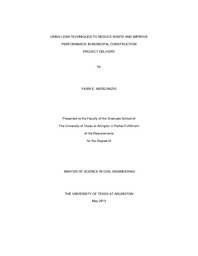| dc.contributor.author | Abdelrazig, Yasir E. | en_US |
| dc.date.accessioned | 2015-07-31T22:10:04Z | |
| dc.date.available | 2015-07-31T22:10:04Z | |
| dc.date.submitted | January 2015 | en_US |
| dc.identifier.other | DISS-13057 | en_US |
| dc.identifier.uri | http://hdl.handle.net/10106/25028 | |
| dc.description.abstract | The basic concepts of lean thinking in construction projects are to reduce waste, improve communication, and promote teamwork integration through a common set of tools and techniques. With increased demand for public works projects, there is a need to focus attention on the efficient delivery of construction project services in the public sector, and in particular, on municipal project delivery. Performance improvements using lean techniques are considered to overcome problems, facilitate project progress, and offer recommendations for better municipal construction project processes. Municipal projects are a part of the public works which include a broad category of infrastructure projects, financed and constructed by the government, for uses in the greater community. Municipal construction projects have special challenges that may differ from other construction projects. These projects include a vast area and scatter around the city and local government region. To achieve total project's owner satisfaction and improve operational effectiveness and efficiency, lean concept is to find the waste in each municipal construction work and isolate them. Non-physical waste within construction processes is the basis of waste concept adopted by lean construction approach. This study adopts and extends a controllable waste classification using the Analytical Hierarchy Process (AHP). The research approach determines a goal, identifies and categorizes the waste, and takes the action by applying the appropriate lean techniques. A comparison-based survey was conducted to quantify relative priorities for a given set of alternatives on a ratio scale based on the judgment of the construction entities' experience. Through the AHP approach, the survey result helped the decision-makers to reach their goal through demonstrating the decision-making problem as a hierarchy of criteria and alternatives. Many alternatives of lean techniques were identified and prioritized to support in reaching the optimum goal of waste reduction and performance improvement. | en_US |
| dc.description.sponsorship | Najafi, Mohammad | en_US |
| dc.language.iso | en | en_US |
| dc.publisher | Civil & Environmental Engineering | en_US |
| dc.title | Using Lean Techniques To Reduce Waste And Improve Performance In Municipal Project Delivery | en_US |
| dc.type | M.S. | en_US |
| dc.contributor.committeeChair | Najafi, Mohammad | en_US |
| dc.degree.department | Civil & Environmental Engineering | en_US |
| dc.degree.discipline | Civil & Environmental Engineering | en_US |
| dc.degree.grantor | University of Texas at Arlington | en_US |
| dc.degree.level | masters | en_US |
| dc.degree.name | M.S. | en_US |

